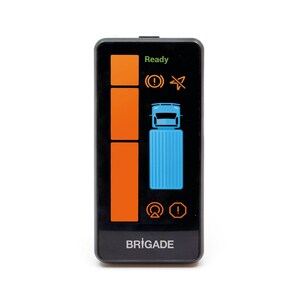Brigade Electronics discusses high definition versus standard definition CCTV cameras for vehicle safety
PORTLAND, Ind., Nov. 24, 2020 /PRNewswire/ -- Vehicle CCTV has grown in popularity over the last few years with many fleet operators choosing to equip their vehicles with the technology to improve safety, support driver training, and prevent fraudulent claims. Vehicle CCTV has even helped to reduce insurance premiums for companies, with the recorded footage proving invaluable when it comes to settling conflicting reports, providing invaluable evidence, and deterring perpetrators from targeting vehicles.
For fleet operators considering investing in commercial vehicle CCTV, understanding the benefits of each system and what is most appropriate could save money in the long term. Here, Corey Heniser, from Brigade Electronics INC, explains the differences between high definition and standard cameras.
High Definition v Standard Definition Vehicle CCTV
The main difference between high definition (HD) and standard definition (SD) is the number of pixels contained in the displayed image. HD images have more pixels per square inch compared to SD, meaning a HD system will provide much clearer pictures with finer details. Typically, HD is referred to as a 720p and above.
Ultimately, HD will provide more clarity and detail, allowing drivers to see an object or person in a vehicle's blind spot with ease so they can act quickly to prevent a collision.
HD formats – analogue v digital
The HD system is available in two different formats – analogue or digital. Ultimately, this refers to the method which footage is recorded and delivered.
Analogue cameras capture images and send the signal over coaxial cables (a type of electrical cable) to a recorder or ECU (electronic control unit). These images are then converted from an analogue format into digital signals, compressed and then stored on a hard drive or shown in real time on a monitor.
Digital cameras or IP cameras (internet protocol cameras) capture images digitally from the outset. These cameras send data over a computer network rather than via a recorder or ECU first.
How to decide which format is best
IP cameras offer high-definition footage via a digital camera with its own IP address. Instead of transmitting video over a video cable to a monitor, the IP cameras transmit via a data connection where images are safely stored to the HDD memory. This means they can be connected easily to expansion modules using Power Over Network (PON) without the need to invest in expensive additional equipment.
Due to video latency (effectively a time lag for footage appearing on screen) IP cameras should not be relied on as an aid for maneuvering or blind spot monitoring. However, IP cameras are an excellent choice for general monitoring of vehicles, such as ensuring passengers are safely seated on buses, and doors are not obstructed before a vehicle pulls away.
Analogue HD cameras on the other hand have no video latency making them ideal for providing drivers with a clear view in real-time. This also means that on-screen display menus are supported, offering a better user experience during operation. Analogue HD technology can transmit video over traditional cabling across distances of up to 1640 feet – plenty of cable length for any commercial vehicle.
Monitors for viewing HD footage
To view HD footage, drivers will require a HD compatible monitor. Monitors that only support SD footage can still display images from a HD camera, but without the benefits of the clarity that HD offers. For example, if the image is a HD quality of 1080p, but the monitor can only display 480 pixels per square inch, the driver will still only receive a SD image.
Watch Brigade's AHD vs SD video.
SOURCE Brigade Electronics

WANT YOUR COMPANY'S NEWS FEATURED ON PRNEWSWIRE.COM?
Newsrooms &
Influencers
Digital Media
Outlets
Journalists
Opted In





Share this article